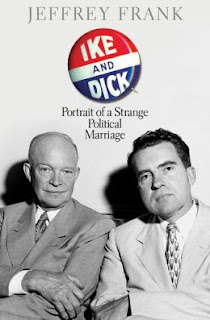 including the “Washington Trilogy”—The Columnist, Bad Publicity, and Trudy Hopedale.
including the “Washington Trilogy”—The Columnist, Bad Publicity, and Trudy Hopedale.He applied the “Page 99 Test” to his new book, Ike and Dick: Portrait of a Strange Political Marriage, and reported the following:
Ike and Dick: Portrait of a Strange Political Marriage examines the personal and political relationship of Dwight D. Eisenhower and Richard Nixon as it evolved over nearly twenty years--from their first meeting, in 1950, at the Bohemian Grove until Eisenhower's death, in March, 1969. The two men, both of whom became American presidents, were far more complex than their popular images suggest. Ike--“General Ike”-- was widely regarded as warm and transparently honest, but he could be chilly and cunning at times; Nixon--“Tricky Dick” to his critics--was often regarded as paranoid and vicious, but he could be kind and empathetic.Learn more about the book and author at Jeffrey Frank's website.
You can see both sides of Nixon on Page 99 of Ike and Dick, which picks up in the middle of the 1954 midterm elections-- a particularly interesting moment for Vice President Nixon, demonstrating both the rock-em, sock-em campaigner and the early champion of civil rights.
Nixon that year was sent out to thirty states and nearly a hundred cities, during which he urged voters to support a Republican Congress “that will assure our children the right to grow up under American prosperity and not socialism.” It was an exhausting campaign--he traveled some 25,000 miles in a United Airlines Convair--and journalists noted the difference between the statesmanlike man who’d toured the world a year earlier and made a generally good impression and this over-the-top partisan, who at one point seemed to suggest that the Democratic Party was more accommodating to Communists than the Republican Party. (Democrats later installed a Hall of Smears to commemorate the campaign year.)
But then, quoting from the book, “There were occasional glimpses of another, temperate Nixon, as when he talked with approval” about the Supreme Court’s Brown decision, issue in May of 1954, which overturned state laws establishing separate schools for black and white students. “There are six hundred million people in the world who hold the balance of power, and who are not white,” he said, and added, “One of the factors that would be tremendously helpful is for us here in the United States to show by example, by word and deed that the dream of equality--equality of opportunity, of education, and of employment and the like--is coming true.”
Those impromptu remarks, delivered at an airport in Wilmington, Delaware, where residents were resisting the idea of school integration, so impressed a New York Times reporter who was present that he wrote to Nixon, expressing admiration and regretting that his account was truncated in the edition that most Times readers got.
Writers Read: Jeffrey Frank (December 2008).
--Marshal Zeringue



